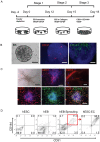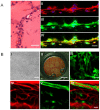Functional and transcriptional characterization of human embryonic stem cell-derived endothelial cells for treatment of myocardial infarction
- PMID: 20046878
- PMCID: PMC2795856
- DOI: 10.1371/journal.pone.0008443
Functional and transcriptional characterization of human embryonic stem cell-derived endothelial cells for treatment of myocardial infarction
Abstract
Background: Differentiation of human embryonic stem cells into endothelial cells (hESC-ECs) has the potential to provide an unlimited source of cells for novel transplantation therapies of ischemic diseases by supporting angiogenesis and vasculogenesis. However, the endothelial differentiation efficiency of the conventional embryoid body (EB) method is low while the 2-dimensional method of co-culturing with mouse embryonic fibroblasts (MEFs) require animal product, both of which can limit the future clinical application of hESC-ECs. Moreover, to fully understand the beneficial effects of stem cell therapy, investigators must be able to track the functional biology and physiology of transplanted cells in living subjects over time.
Methodology: In this study, we developed an extracellular matrix (ECM) culture system for increasing endothelial differentiation and free from contaminating animal cells. We investigated the transcriptional changes that occur during endothelial differentiation of hESCs using whole genome microarray, and compared to human umbilical vein endothelial cells (HUVECs). We also showed functional vascular formation by hESC-ECs in a mouse dorsal window model. Moreover, our study is the first so far to transplant hESC-ECs in a myocardial infarction model and monitor cell fate using molecular imaging methods.
Conclusion: Taken together, we report a more efficient method for derivation of hESC-ECs that express appropriate patterns of endothelial genes, form functional vessels in vivo, and improve cardiac function. These studies suggest that hESC-ECs may provide a novel therapy for ischemic heart disease in the future.
Conflict of interest statement
Figures







Similar articles
-
Functional characterization and expression profiling of human induced pluripotent stem cell- and embryonic stem cell-derived endothelial cells.Stem Cells Dev. 2011 Oct;20(10):1701-10. doi: 10.1089/scd.2010.0426. Epub 2011 Feb 28. Stem Cells Dev. 2011. PMID: 21235328 Free PMC article.
-
Therapeutic angiogenesis by transplantation of human embryonic stem cell-derived CD133+ endothelial progenitor cells for cardiac repair.Regen Med. 2010 Mar;5(2):231-44. doi: 10.2217/rme.09.83. Regen Med. 2010. PMID: 20210583
-
Bioluminescence imaging of human embryonic stem cell-derived endothelial cells for treatment of myocardial infarction.Methods Mol Biol. 2013;1052:203-15. doi: 10.1007/7651_2013_15. Methods Mol Biol. 2013. PMID: 23733538
-
Transplantation of human embryonic stem cell-derived endothelial cells for vascular diseases.J Cell Biochem. 2009 Feb 1;106(2):194-9. doi: 10.1002/jcb.22003. J Cell Biochem. 2009. PMID: 19097085 Free PMC article. Review.
-
Strategies for derivation of endothelial lineages from human stem cells.Stem Cell Res Ther. 2019 Jul 8;10(1):200. doi: 10.1186/s13287-019-1274-1. Stem Cell Res Ther. 2019. PMID: 31286997 Free PMC article. Review.
Cited by
-
A Scalable and Efficient Bioprocess for Manufacturing Human Pluripotent Stem Cell-Derived Endothelial Cells.Stem Cell Reports. 2018 Aug 14;11(2):454-469. doi: 10.1016/j.stemcr.2018.07.001. Epub 2018 Aug 2. Stem Cell Reports. 2018. PMID: 30078557 Free PMC article.
-
Generation of Endothelial Cells From Human Pluripotent Stem Cells.Arterioscler Thromb Vasc Biol. 2019 Jul;39(7):1317-1329. doi: 10.1161/ATVBAHA.119.312265. Epub 2019 May 9. Arterioscler Thromb Vasc Biol. 2019. PMID: 31242035 Free PMC article. Review.
-
Functional characterization and expression profiling of human induced pluripotent stem cell- and embryonic stem cell-derived endothelial cells.Stem Cells Dev. 2011 Oct;20(10):1701-10. doi: 10.1089/scd.2010.0426. Epub 2011 Feb 28. Stem Cells Dev. 2011. PMID: 21235328 Free PMC article.
-
Three-Dimensional Vascular Network Assembly From Diabetic Patient-Derived Induced Pluripotent Stem Cells.Arterioscler Thromb Vasc Biol. 2015 Dec;35(12):2677-85. doi: 10.1161/ATVBAHA.115.306362. Epub 2015 Oct 8. Arterioscler Thromb Vasc Biol. 2015. PMID: 26449749 Free PMC article.
-
Enhanced Therapeutic and Long-Term Dynamic Vascularization Effects of Human Pluripotent Stem Cell-Derived Endothelial Cells Encapsulated in a Nanomatrix Gel.Circulation. 2017 Nov 14;136(20):1939-1954. doi: 10.1161/CIRCULATIONAHA.116.026329. Epub 2017 Sep 29. Circulation. 2017. PMID: 28972000 Free PMC article.
References
-
- Wollert KC, Drexler H. Clinical applications of stem cells for the heart. Circ Res. 2005;96:151–163. - PubMed
-
- Laflamme MA, Murry CE. Regenerating the heart. Nat Biotechnol. 2005;23:845–856. - PubMed
-
- Huang PP, Yang XF, Li SZ, Wen JC, Zhang Y, et al. Randomised comparison of G-CSF-mobilized peripheral blood mononuclear cells versus bone marrow-mononuclear cells for the treatment of patients with lower limb arteriosclerosis obliterans. Thromb Haemost. 2007;98:1335–1342. - PubMed
-
- Yang C, Zhang ZH, Li ZJ, Yang RC, Qian GQ, et al. Enhancement of neovascularization with cord blood CD133+ cell-derived endothelial progenitor cell transplantation. Thromb Haemost. 2004;91:1202–1212. - PubMed
-
- Heeschen C, Chang E, Aicher A, Cooke JP. Endothelial progenitor cells participate in nicotine-mediated angiogenesis. J Am Coll Cardiol. 2006;48:2553–2560. - PubMed
Publication types
MeSH terms
Substances
Grants and funding
LinkOut - more resources
Full Text Sources
Other Literature Sources
Medical
Molecular Biology Databases

